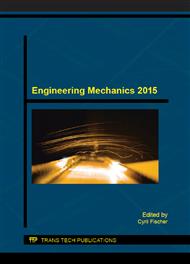[1]
NOVOTNÝ, Pavel, PÍŠTĚK, Václav and DRÁPAL, Lubomír. New Efficient Methods for Powertrain Vibration Analysis. Proceedings of the Institution of Mechanical Engineers, Part D: Journal of Automobile Engineering. 2010. vol. 224, no. 5, pp.611-629.
DOI: 10.1243/09544070jauto1277
Google Scholar
[2]
ORTJOHANN, Timo, VONCKEN, Antonius and PISCHINGER, Stefan. Piston Ring Dynamics Simulation Based on FEA Software. MTZ worldwide. 2008. vol. 69, no. 12, pp.36-41. DOI: 10. 1007/BF03226936.
DOI: 10.1007/bf03226936
Google Scholar
[3]
ARCOUMANIS, Constantine, OSTOVAR, Pendar and MORTIER, Roy. Mixed Lubrication Modelling of Newtonian and Shear Thinning Liquids in a Piston-Ring Configuration. SAE Technical Paper 972924. 1997. DOI: 10. 4271/972924.
DOI: 10.4271/972924
Google Scholar
[4]
WANNATONG, Krisada. Simulation Algorithm for Piston Ring Dynamics. Simulation Modelling Practice and Theory. 2008. vol. 16, no. 1, pp.127-146. DOI: 10. 4271/2001-01-3368.
DOI: 10.1016/j.simpat.2007.11.004
Google Scholar
[5]
FURUHAMA, Shouichi and TADA, Tosio. On the Flow of Gas Through the Piston-Rings: 1st Report, The Discharge Coefficient and Temperature of Leakage Gas. Transactions of the Japan Society of Mechanical Engineers. 1961. vol. 27, no. 174, pp.240-247.
DOI: 10.1299/kikai1938.27.240
Google Scholar
[6]
PATIR, Nadir and CHENG, H. S. An Average Flow Model for Determining Effects of Three-Dimensional Roughness on Partial Hydrodynamic Lubrication. Journal of Lubrication Technology. 1978. vol. 100, no. 1, pp.12-17. DOI: 10. 1115/1. 3453103.
DOI: 10.1115/1.3453103
Google Scholar
[7]
GREENWOOD, J. A. and TRIPP, J. H. The Contact of Two Nominally Flat Rough Surfaces. Proceedings of the Institution of Mechanical Engineers. 1970. vol. 185, no. 1, pp.625-634. DOI: 10. 1243/PIME_PROC_1970_185_069_02.
DOI: 10.1243/pime_proc_1970_185_069_02
Google Scholar


